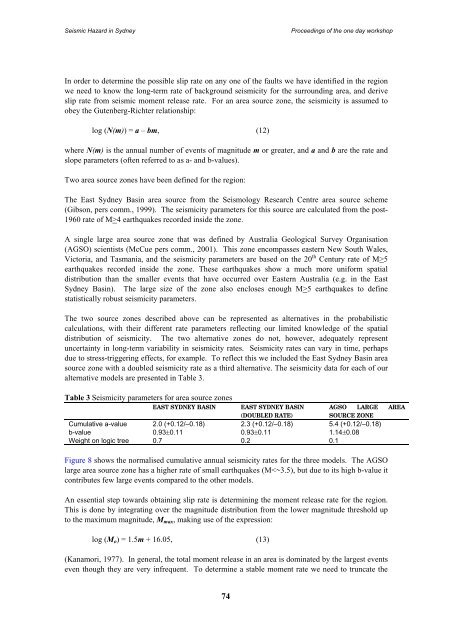Landslides in the Sydney Basin - Geoscience Australia
Landslides in the Sydney Basin - Geoscience Australia
Landslides in the Sydney Basin - Geoscience Australia
- No tags were found...
You also want an ePaper? Increase the reach of your titles
YUMPU automatically turns print PDFs into web optimized ePapers that Google loves.
Seismic Hazard <strong>in</strong> <strong>Sydney</strong>Proceed<strong>in</strong>gs of <strong>the</strong> one day workshopIn order to determ<strong>in</strong>e <strong>the</strong> possible slip rate on any one of <strong>the</strong> faults we have identified <strong>in</strong> <strong>the</strong> regionwe need to know <strong>the</strong> long-term rate of background seismicity for <strong>the</strong> surround<strong>in</strong>g area, and deriveslip rate from seismic moment release rate. For an area source zone, <strong>the</strong> seismicity is assumed toobey <strong>the</strong> Gutenberg-Richter relationship:log (N(m)) = a – bm, (12)where N(m) is <strong>the</strong> annual number of events of magnitude m or greater, and a and b are <strong>the</strong> rate andslope parameters (often referred to as a- and b-values).Two area source zones have been def<strong>in</strong>ed for <strong>the</strong> region:The East <strong>Sydney</strong> Bas<strong>in</strong> area source from <strong>the</strong> Seismology Research Centre area source scheme(Gibson, pers comm., 1999). The seismicity parameters for this source are calculated from <strong>the</strong> post-1960 rate of M>4 earthquakes recorded <strong>in</strong>side <strong>the</strong> zone.A s<strong>in</strong>gle large area source zone that was def<strong>in</strong>ed by <strong>Australia</strong> Geological Survey Organisation(AGSO) scientists (McCue pers comm., 2001). This zone encompasses eastern New South Wales,Victoria, and Tasmania, and <strong>the</strong> seismicity parameters are based on <strong>the</strong> 20 th Century rate of M>5earthquakes recorded <strong>in</strong>side <strong>the</strong> zone. These earthquakes show a much more uniform spatialdistribution than <strong>the</strong> smaller events that have occurred over Eastern <strong>Australia</strong> (e.g. <strong>in</strong> <strong>the</strong> East<strong>Sydney</strong> Bas<strong>in</strong>). The large size of <strong>the</strong> zone also encloses enough M>5 earthquakes to def<strong>in</strong>estatistically robust seismicity parameters.The two source zones described above can be represented as alternatives <strong>in</strong> <strong>the</strong> probabilisticcalculations, with <strong>the</strong>ir different rate parameters reflect<strong>in</strong>g our limited knowledge of <strong>the</strong> spatialdistribution of seismicity. The two alternative zones do not, however, adequately representuncerta<strong>in</strong>ty <strong>in</strong> long-term variability <strong>in</strong> seismicity rates. Seismicity rates can vary <strong>in</strong> time, perhapsdue to stress-trigger<strong>in</strong>g effects, for example. To reflect this we <strong>in</strong>cluded <strong>the</strong> East <strong>Sydney</strong> Bas<strong>in</strong> areasource zone with a doubled seismicity rate as a third alternative. The seismicity data for each of ouralternative models are presented <strong>in</strong> Table 3.Table 3 Seismicity parameters for area source zonesEAST SYDNEY BASINEAST SYDNEY BASIN(DOUBLED RATE)AGSO LARGE AREASOURCE ZONECumulative a-value 2.0 (+0.12/–0.18) 2.3 (+0.12/–0.18) 5.4 (+0.12/–0.18)b-value 0.93±0.11 0.93±0.11 1.14±0.08Weight on logic tree 0.7 0.2 0.1Figure 8 shows <strong>the</strong> normalised cumulative annual seismicity rates for <strong>the</strong> three models. The AGSOlarge area source zone has a higher rate of small earthquakes (M
















